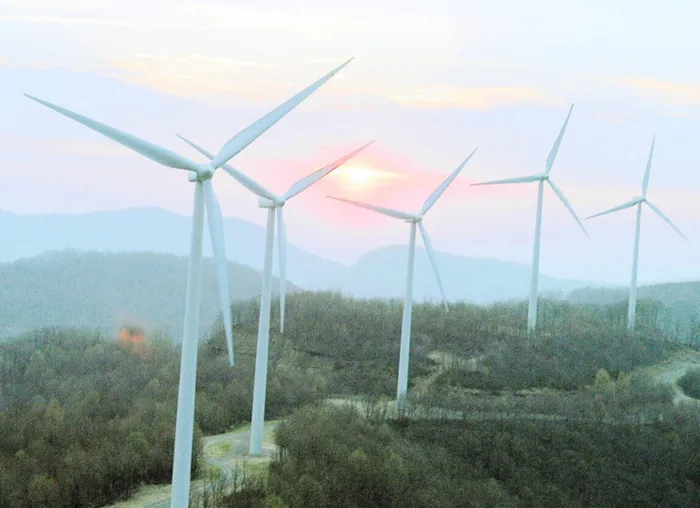Can South Africa achieve Net Zero?

Picture: Supplied – An image of a wind farm. The ANC has eventually identified renewable energy as a key area for investment, and has set a target of generating 42 percent of SA’s electricity from renewable sources by 2030, the writer says.
Picture: John Woodroof/ANA file – Contract workers at Mittal’s Vanderbijlpark steel mill. A steel mill that emits carbon through the smelting process, can commit to planting a million trees in a protected area. The trees will absorb roughly the same amount of carbon that the steel mill emits.
By Dominic Naidoo
According to Net Zero Climate, “net zero refers to a state in which the greenhouse gases going into the atmosphere are balanced by removal of these gases out of the atmosphere”.
For example, a company such as a steel mill emits carbon through the smelting process, something that requires burning vast amounts of coal and gas. To balance out their carbon emissions, the company commits to funding the planting of a few million trees in a protected area.
The trees would absorb roughly the same amount of carbon that the steel mill emits. This would, in theory, allow the steel mill to achieve net zero emissions or carbon neutrality.
The term net zero is important because this is the state at which global warming stops. The Paris Agreement underlines the need for net zero, requiring states to “achieve a balance between anthropogenic emissions by sources and removals by sinks of greenhouse gases in the second half of this century”.
South Africa, like nations the world over, is facing the dual challenge of reducing its greenhouse gas emissions in order to reach the much sought after net zero gold medal.
The energy sector is a significant contributor to South Africa's emissions and to reach the goal of net zero, the government must push forward the transition toward the use of renewable energy sources.
In this article, I explore the current state of South Africa's energy sector, the challenges and opportunities it presents and the steps that need to be taken to achieve net zero via renewables.

The energy sector in SA is dominated by coal, which currently generates over 80 percent of the country's electricity. However, this heavy reliance on coal has resulted in high levels of greenhouse gas emissions, air pollution and placed a massive strain on our energy security.
The ANC energy “gurus” have, playing catch up with reality, eventually identified renewable energy as a key area for investment, and has set a target of generating 42 percent of SA’s electricity from renewable sources by 2030.
According to the Department of Energy and Mineral Resources, the country currently generates a meagre 11 percent of its energy from renewables. But they’re sticking to their guns.
One of the challenges facing South Africa in achieving its renewable energy targets is the lack of investment in the sector. The country has a small and underdeveloped renewable energy market, which makes it difficult for investors to access opportunities and to obtain financing for renewable energy projects. We’re also facing challenges in terms of our, frankly dilapidated, energy infrastructure, which is not yet equipped to support the integration of renewable energy sources into the national grid.
Despite these challenges, South Africa has several opportunities to scale up its use of renewable energy. We have abundant resources for renewable energy, including strong wind and solar potential, a well-developed industrial base and a highly skilled workforce.
Additionally, the cost of renewable energy has fallen dramatically in recent years, making it more economically competitive than traditional sources of energy such as coal and natural gas.
To achieve our ambitious goal of net zero using renewables, South Africa will need to take several key steps, something which may prove too much for the humble Mantashe (Minister of Energy).
Firstly, the government must provide a stable and predictable policy environment to attract investment in the renewable energy sector.
The Renewable Energy Independent Power Producer Procurement Programme (REIPPPP) is a promising start, as it has helped to attract private sector investment in renewable energy projects.
Secondly, increased investment is needed in the development of SA’s energy infrastructure to support the integration of renewable energy sources into the national grid. This includes the construction of new transmission lines and substations, as well as the development of energy storage systems, such as batteries and pumped hydro.
These investments will help to ensure that renewable energy is accessible and affordable for all South Africans.
Thirdly, South Africa must adopt innovative technologies to maximise the use of renewable energy and minimise its dependence on fossil fuels.
For example, the use of smart grid technology can help to improve the efficiency of the energy system, while also reducing emissions. Smart grids are able to monitor and control energy use in real-time, helping to optimise the use of renewable energy sources and minimise the use of fossil fuels.
Finally, we must work together to raise awareness and promote the adoption of renewable energy. This can be done through public education campaigns and the promotion of clean energy products and services.
The country can also encourage the development of a renewable energy industry by providing tax incentives and subsidies for renewable energy projects. In conclusion, as a country, we have the potential to achieve net zero using renewable energy sources. However, this will require a sustained effort from the government, the private sector, and the general public.
By providing a stable and predictable policy environment, investing in energy infrastructure, adopting innovative technologies, and promoting the adoption of renewable energy, we can reduce our emissions, create jobs, and improve energy security for all its citizens.
Dominic Naidoo is an environment activist and writer.
This article is exclusive to The African. To republish, see terms and conditions.